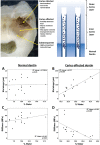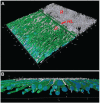Role of dentin MMPs in caries progression and bond stability
- PMID: 25535202
- PMCID: PMC4300303
- DOI: 10.1177/0022034514562833
Role of dentin MMPs in caries progression and bond stability
Abstract
Dentin can be described as a biological composite with collagen matrix embedded with nanosized hydroxyapatite mineral crystallites. Matrix metalloproteinases (MMPs) and cysteine cathepsins are families of endopeptidases. Enzymes of both families are present in dentin and collectively capable of degrading virtually all extracellular matrix components. This review describes these enzymes and their presence in dentin, mainly focusing on their role in dentin caries pathogenesis and loss of collagen in the adhesive hybrid layer under composite restorations. MMPs and cysteine cathepsins present in saliva, mineralized dentin, and/or dentinal fluid may affect the dentin caries process at the early phases of demineralization. Changes in collagen and noncollagenous protein structure may participate in observed decreases in mechanical properties of caries-affected dentin and reduce the ability of caries-affected dentin to remineralize. These endogenous enzymes also remain entrapped within the hybrid layer during the resin infiltration process, and the acidic bonding agents themselves (irrespective of whether they are etch-and-rinse or self-etch) can activate these endogenous protease proforms. Since resin impregnation is frequently incomplete, denuded collagen matrices associated with free water (which serves as a collagen cleavage reagent for these endogenous hydrolase enzymes) can be enzymatically disrupted, finally contributing to the degradation of the hybrid layer. There are multiple in vitro and in vivo reports showing that the longevity of the adhesive interface is increased when nonspecific enzyme-inhibiting strategies are used. Different chemicals (i.e., chlorhexidine, galardin, and benzalkonium chloride) or collagen cross-linker agents have been successfully employed as therapeutic primers in the bonding procedure. In addition, the incorporation of enzyme inhibitors (i.e., quaternary ammonium methacrylates) into the resin blends has been recently promoted. This review will describe MMP functions in caries and hybrid layer degradation and explore the potential therapeutic role of MMP inhibitors for the development of improved intervention strategies for MMP-related oral diseases.
Keywords: cathepsins; collagen; degradation; dentin bonding agents; enzymes; tooth.
© International & American Associations for Dental Research 2014.
Conflict of interest statement
The authors declare no potential conflicts of interest with respect to the authorship and/or publication of this article.
Figures






References
-
- Arola D. 2008. Fracture and aging of dentine. In: Curtis RV, Watson TF, editors. Dental biomaterials: imaging, testing and modeling, Cambridge (UK): Woodhead Publishing Ltd; p. 314–342.
-
- Boukpessi T, Menashi S, Camoin L, Tencate JM, Goldberg M, Chaussain-Miller C. 2008. The effect of stromelysin-1 (MMP-3) on non-collagenous extracellular matrix proteins of demineralized dentin and the adhesive properties of restorative resins. Biomaterials. 29(33):4367–4373. - PubMed
Publication types
MeSH terms
Substances
Grants and funding
LinkOut - more resources
Full Text Sources
Other Literature Sources
Medical

